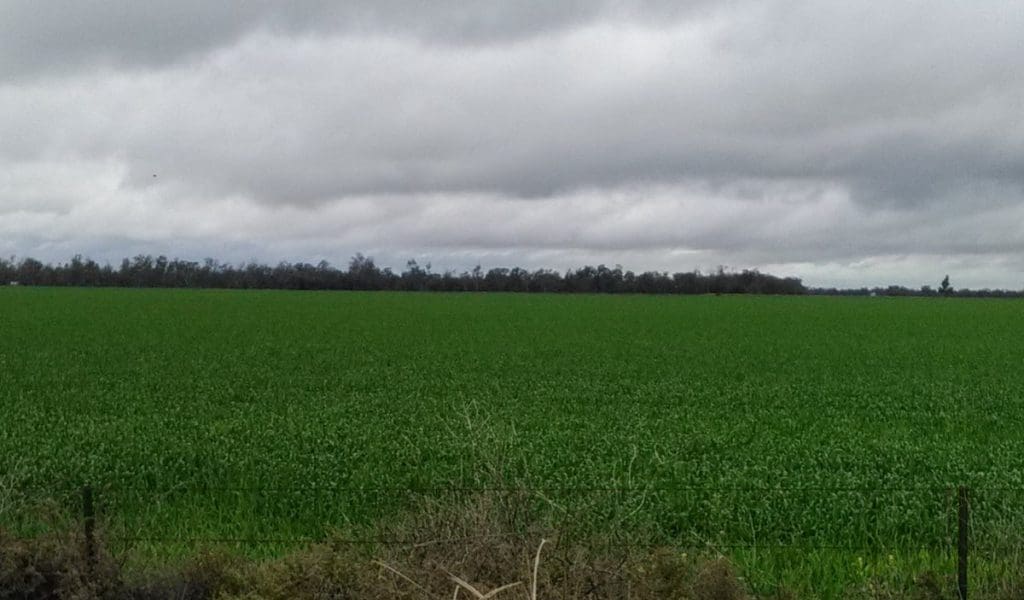
This picture of Spitfire wheat looking good after 37mm of rain was taken by Oscar Pearce on his property 20km east of Moree this week.
WIDESPREAD rain across the eastern cropping belt in the past three days has revived crop prospects, particularly in the north, but added to waterlogging issues for some southern areas.
Farming regions from central Queensland to southern NSW received 20 to 30 millimetres, with some registering far higher and odd areas only a sprinkle.
In North-West NSW, Landmark agronomist, Garry Onus, Moree, NSW, said falls of between 28mm and 68mm had come “just in the nick of time”.
“Some of the crops had their tongues hanging. The tap-rooted crops were still going along alright along with most of the cereals, but the odd one was looking for a drink,” he said.
Mr Onus said the rain meant most crops would now make it through to a harvestable yield, although more rain would be needed to maximise yield potential.
He said farmers who had already been applying fungicide sprays to counter Ascochyta blight in chickpeas in recent weeks would now have to be extra vigilant for further outbreaks.
“We are also coming up to heliothis time in the faba beans and canola. And there are a lot of aphids in wheat and barley already. People are working out whether to spray them or leave them to decrease in numbers naturally,” he said.
Boost to winter/summer crop prospects
In southern Queensland, Dalby Rural Supplies head agronomist, Andrew Johnston, said crops on the Darling Downs were now “in fantastic shape” after falls of 30mm and more.
“Prior to the rain the crops were looking quite good, but we really needed this 30mm. If we had written the script, that is what we wanted. It really sets us up now for a good winter and gives us the moisture to get rolling with spring planting in mid-September,” he said.
Mr Johnston said the heaviest falls were in the western regions where 50mm and more fell around locations such as Moonie, Condamine and Mitchell.
“In the western areas there is water lying in the melon-hole country and contoured areas, so the western growers won’t want any more rain for quite a while,” he said.
He said with such a big planting of chickpeas this year, growers would need to focus on managing Ascochyta which had already impacted crops, even some tolerant varieties, prior to the rain.
“It is off the back of the massive chickpea planting last year which set the bar high from day one. The inoculum has been there. It only needed a minor trigger point to get things rolling. We have had 5mm, 10mm and 15mm falls all winter which has kept things going,” he said.
Mixed fortunes for south
In the southern growing regions of southern NSW and northern Victoria where this week’s falls came on the back of an already wet season, Grassroots Agronomy consultant, Greg Condon, Junee, NSW, said farmers were going into spring with a full soil profile of moisture.
“We are set up now for good yields towards the business end of the season, particularly with canola and wheat and some of the pulse crops. Faba beans are looking really good,” he said.
Mr Condon said the only down side of the recent rain was that on the clay soil areas inundated by earlier falls, crops were suffering yield losses, particularly barley and canola that had become waterlogged.
“That will take the shine off some of those areas, but generally on the loam and lighter soil types the crops are set up for an impressive year,” he said.
He said farmers were actively applying strategies to prevent Sclerotinia in canola and manage leaf disease in barley.
They had also invested heavily in nitrogen this year, particularly in canola, taking advantage of urea prices at 10-year lows and a full profile of moisture.
A rain front forecast to move into Western Australia tomorrow and move across the continent will bring the prospect of further rain for the eastern farming zone mid next week.
Indicative rainfall recordings in the past week:
Central Highlands, Qld: Capella 13mm; Emerald 17mm; Rolleston 28mm.
Darling Downs, Qld: Dalby 25mm; Drillham 34mm; Pittsworth 32mm; Meandarra 64mm.
Maranoa, Qld: Mitchell 69mm; Roma 32mm; Wallumbilla 41mm.
North-West, NSW: Gunnedah 45mm; Narrabri 64mm; Walgett 17mm.
Central-West, NSW: Condobolin 19mm; Cowra 22mm; Dubbo 22mm; Nyngan 14mm.
South-West Slopes, NSW: Cootamundra 39mm; Wagga Wagga 26mm.
Riverina, NSW: Deniliquin 11mm; Griffith 26mm.
Wimmera, Vic: Donald 10mm; Horsham 9mm.
Mallee, Vic: Ouyen 4mm; Swan Hill 7mm.

Nice article Neil.